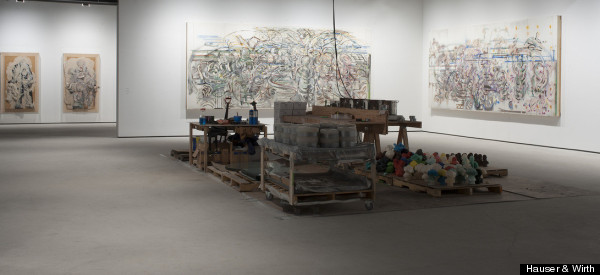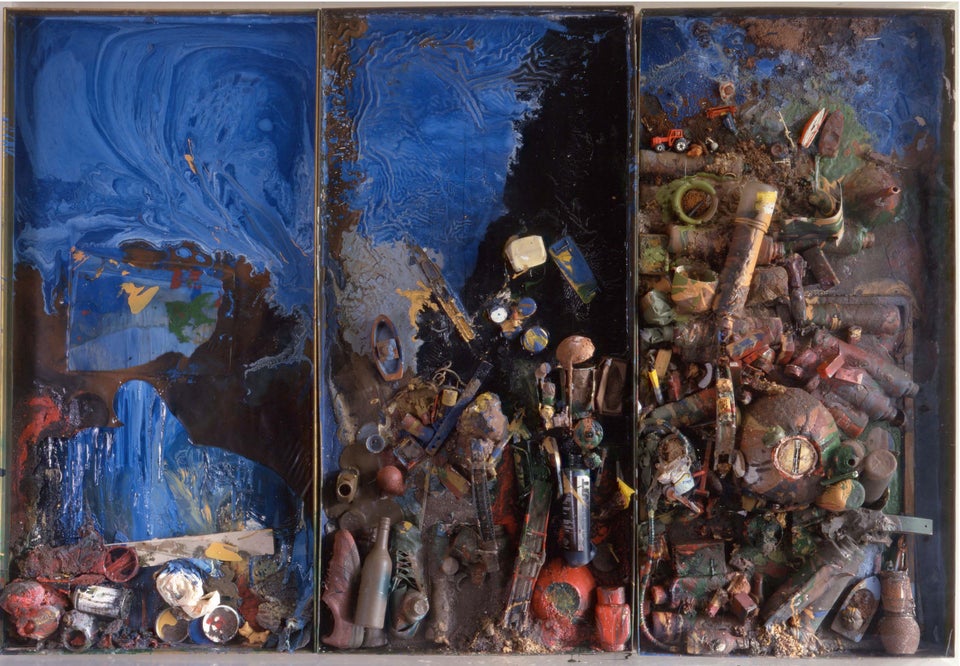
Anyone who has spent an evening gallery-hopping in Chelsea knows that exhibition openings are as much about the schmoozing and imbibing on free drinks as they are about the artwork. At the opening of "Dieter Roth. Björn Roth," at Hauser & Wirth's new Chelsea location on Wednesday, this was more clear than ever. Gallery-goers had no qualms about making a beeline for the bar. But in this case, the drinks were part of the art. Roth New York Bar, 2013 was both an installation in the show and fully functioning bar, complete with Coronas, Guinness, and coffee, all served free of charge by a duo of energetic young bartenders. The joint was hopping.
Dieter Roth -- a Swiss-German artist who died in 1998, and whose work fills most of the gargantuan space -- would have appreciated the sight of a lively bar scene in the middle of a Chelsea gallery. For Roth, there were no boundaries between life and art; the two were interchangeable.

This was especially evident in Roth's "Grosse Tischruine" or "Large Table Ruin", a sprawling sculptural installation at the far end of the gallery. The work was composed of a maze of worktables imported from Dieter Roth's various studios, piled high with a stalagmitic accumulation of junk -- snarls of wire, rolls of film unfurling onto the floor, jars of paint, photographs, old shoes, ladders, and make-shift wooden poles that were erected for the purpose of displaying even more junk.
Roth began this project of aggregation in 1970 and added to it for the rest of his life, often in collaboration with Eggert Einarsson and his son Björn. The nest of material they gathered, and all the weird, dusty detail it contains, is worth spending time with: it evokes an erratic, passionate, dark and joyously obsessive life, but also a life unrestrained -- the crates of empty beer bottles are an ominous reminder of the artist's death of an illness related to alcoholism. Björn, who was told by his father to "either leave it or continue," has chosen the latter. And now he and his sons, Oddur and Einar, have taken on the responsibility of carrying Roth senior's work forward.
The most instantly captivating works in the show are the two confectionary columns: the Sugar Tower and the Chocolate Tower, erected in the middle of the gallery. The chocolate imparts a strong sweet smell -- the first thing you notice upon entering the gallery. Each tower is composed of small molded busts lined up on glass shelves, which are stacked in narrow pillars nearly as high as the ceiling. The busts are self-portraits of Dieter Roth as an old man, as the Sphinx or as a lion made from chocolate or brightly colored sugar.
The towers have a dazzling physical presence and look both humorous and oddly mystical, like totem poles created by a revered leader that reflect a clan lineage -- that of Roth and his descendants. As the story goes, in 1994, the first sugar tower caved in. But in the last year of his life, Roth admonished his son to rebuild it using the damaged busts from the original tower. The construction in the gallery is a reimagining of the original by Björn, Oddur and Einar and reflective of the work begun by Roth that has become something a family trade. And like the best of Roth's work -- works made from organic materials like sausages made from the shredded books of Gunter Grass and the Daily Mirror, bananas pressed into linen, and the 37 suitcases filled with cheese--they embrace decay while enduring into the present.
As radical as Dieter Roth was in his day, the works on display at Hauser & Wirth feel surprisingly at home amongst the found art, food-as-art, performance and large-scale installations that are becoming regular fare for young artists today.
Negotiating the line between art and life with Roth's finesse can be tricky. The bar, which was created by Björn and Oddur for the show, could feel gimmicky in isolation. But in the context and layout of the show it makes perfect sense. In order to approach the bar and order your Corona, you have to walk through a narrow corridor past one of Roth's most powerful works, "Solo Scenes" -- a wall of 128 video monitors showing footage that the artist took of himself during the last year of his life doing mundane daily activities like showering, reading in bed, or sitting on the toilet. At the end of this glowing hall you reach the bar, a bustling reaffirmation of Roth's life and the performative impulse that was so important to him. Less important are the things in the bar that attempt to resonate with the weighty details of Large Table Ruin -- the dangling clamp lights, vitrines filled with curious objects and television monitors. More important is that you kick back in the space, try not to think too hard about whether or not it's art, and live a little.
